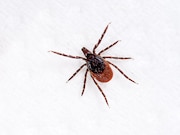Diagnostic and surveillance limitations and lack of treatment options, vaccines hamper efforts
THURSDAY, Sept. 6, 2018 (HealthDay News) — Though the incidence of tickborne infections in the United States has risen significantly within the past decade, prevention and management are hampered by inadequate diagnostics as well as a lack of treatment options and vaccines, according to a perspective article published in the Aug. 23 issue of the New England Journal of Medicine.
Noting that the number of reported cases of tickborne disease has more than doubled in the last 13 years, Catharine I. Paules, M.D., from the National Institutes of Health in Bethesda, Md., and colleagues write that the public health burden of tickborne pathogens is considerably underestimated. For example, there are approximately 30,000 cases of Lyme disease reported annually in the United States, but experts estimate that the true incidence may be 10 times higher. This underestimation is due to the limitations of current tickborne disease surveillance, as well as current diagnostic testing tools, which may be unable to recognize new tickborne pathogens as they emerge.
Although there are effective therapies available for common tickborne bacteria and parasites, there are none for tickborne viruses such as Powassan virus. In addition, there are no licensed vaccines for humans targeting tickborne pathogens. One promising vaccine that was previously marketed to prevent Lyme disease was withdrawn from the market by the manufacturer, for reasons including falling sales and liability concerns.
“Prevention and management are hampered by suboptimal diagnostics, lack of treatment options for emerging viruses, and a paucity of vaccines,” the authors write. “If public health and biomedical research professionals accelerate their efforts to address this threat, we may be able to fill these gaps.”
Copyright © 2018 HealthDay. All rights reserved.








